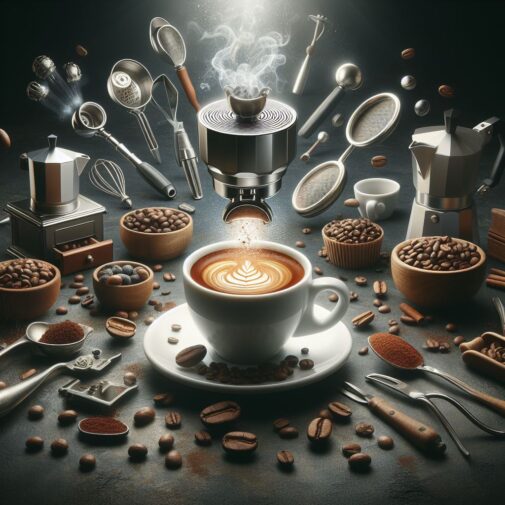Bean to Cup: Unveiling the Secrets Behind the Perfect Espresso
For coffee enthusiasts, there’s nothing quite like the aroma and flavor of a perfectly brewed espresso. That rich, velvety shot of caffeine has the power to awaken the senses and provide a moment of pure indulgence. But what goes into making that perfect espresso? In this article, we will unveil the secrets behind achieving the ideal espresso, from selecting the right beans to mastering the art of brewing. Whether you’re a home barista or a coffee shop owner, these tips and insights will help you elevate your coffee game and create a truly exceptional espresso experience.
Article Highlights
-
Introduction
-
The Importance of Bean Selection
-
Understanding the Roasting Process
-
The Art of Grinding
-
Mastering the Espresso Machine
-
The Perfect Extraction
-
Milk Steaming and Latte Art
-
Pro Tips for Enjoying Your Perfect Espresso
-
Conclusion

1. The Importance of Bean Selection
The journey to the perfect espresso begins with the selection of high-quality coffee beans. The beans you choose will greatly impact the taste and aroma of your espresso. Here are some key factors to consider when selecting beans:
– Origin: Different coffee-growing regions produce beans with unique flavor profiles. Whether you prefer the bright acidity of Ethiopian beans or the chocolaty richness of Brazilian beans, understanding the origin can help you choose the right beans to achieve the desired flavor in your espresso.
– Roast Level: The roast level of the beans also plays a crucial role in espresso preparation. Lighter roasts tend to have more acidity and floral notes, while darker roasts offer a bolder and more robust flavor. Experiment with different roast levels to find your preferred balance.
– Freshness: Freshly roasted beans are essential for a great espresso. Look for beans roasted within the past two weeks, as they retain more flavor and complexity. Avoid pre-ground coffee and opt for whole beans that you can grind just before brewing.
2. Understanding the Roasting Process
Roasting is a critical step in coffee production that transforms green coffee beans into the aromatic brown beans we’re familiar with. Understanding the roasting process can help you appreciate the nuances of flavor and achieve the perfect espresso. Here’s a simplified overview:
– Development of Flavors: During roasting, the beans undergo complex chemical reactions that develop their unique flavors. Acids break down, sugars caramelize, and aromatic compounds are formed. The roast level determines the balance of these flavors.
– Roast Profiles: Roasters carefully control temperature and duration to create specific roast profiles. Light roasts preserve the bean’s intrinsic flavors, while darker roasts bring out deep, smoky notes. Medium roasts strike a balance between acidity and body.
– Freshness and Degassing: After roasting, beans release carbon dioxide gas, known as degassing. It’s crucial to allow beans to rest for a few days to a week to achieve optimal flavor. Freshly roasted beans need time to degas before grinding and brewing.
3. The Art of Grinding
The coarseness or fineness of your coffee grounds significantly affects the extraction process and the resulting flavor of your espresso. Achieving the perfect grind consistency is key. Consider these points when grinding your beans:
– Burr Grinder: Invest in a burr grinder for a consistent grind size. Blade grinders can create uneven particle sizes, resulting in under-extraction or over-extraction. Burr grinders offer more control and precision.
– Grind Size: Espresso requires a fine grind to maximize extraction. The ideal grind should resemble granulated sugar. Experiment with different grind sizes to find the sweet spot for your espresso machine.
– Dosing and Tamping: Consistency in dosing (the amount of coffee used) and tamping (compressing the coffee in the portafilter) is crucial. Aim for a level and evenly tamped bed of coffee to ensure even extraction and avoid channeling.
4. Mastering the Espresso Machine
An espresso machine is a barista’s tool of the trade. Understanding its features and functions is essential for achieving the perfect espresso. Here are some key considerations:
– Temperature: Espresso machines should maintain stable water temperature throughout the brewing process. The ideal range is between 195°F and 205°F (90°C to 96°C). Proper temperature ensures optimal extraction and prevents over- or under-extraction.
– Pressure: Espresso machines use pressure to force hot water through the coffee grounds. The standard pressure for espresso extraction is 9 bars. Consistent pressure results in a balanced extraction, creating a flavorful and aromatic shot.
– Pre-infusion: Some espresso machines offer pre-infusion, a process thatprepares the coffee grounds by saturating them with hot water before full extraction. Pre-infusion helps to release trapped gases, allowing for a more even extraction and enhanced flavors in the final shot.
5. The Perfect Extraction
Achieving the perfect extraction is the ultimate goal in brewing espresso. It involves extracting the desirable flavors from the coffee grounds while avoiding bitter or sour notes. Consider the following factors for a well-extracted espresso:
– Brew Time: The ideal brew time for a shot of espresso is typically between 25 to 35 seconds. If the shot pulls too quickly, it may be under-extracted and taste sour. Conversely, an over-extracted shot may taste bitter and dry. Adjust your grind size and dose to achieve the desired extraction time.
– Shot Volume: A standard espresso shot is typically around 1 to 1.5 ounces (30 to 45 milliliters). However, shot volume can vary based on personal preference and the espresso recipe you’re following. Experiment with different volumes to find the right balance of strength and flavor.
– Crema: Crema, the golden foamy layer that sits atop a well-pulled espresso shot, is a sign of a good extraction. It contains oils and aromatic compounds that contribute to the overall flavor and mouthfeel. A thick, velvety crema indicates a well-balanced shot.
6. Milk Steaming and Latte Art
For those who enjoy milk-based espresso beverages like lattes and cappuccinos, mastering the art of milk steaming is essential. Here are some tips to achieve silky-smooth milk and create beautiful latte art:
– Quality Milk: Choose high-quality, fresh milk with a higher fat content for better texture and flavor. Whole milk or 2% milk is commonly used for steaming. Non-dairy alternatives can also be used, but they may behave differently during the steaming process.
– Temperature and Texture: Aim to steam milk to a temperature between 140°F to 160°F (60°C to 71°C). Texturing the milk involves introducing air to create a creamy and velvety micro-foam. Practice is key to achieving the desired texture.
– Latte Art Techniques: Once you’ve achieved the perfect milk texture, you can try your hand at latte art. Pouring techniques like the heart, tulip, and rosetta can add a visual element to your espresso creations. Keep practicing and experimenting to refine your skills.
7. Pro Tips for Enjoying Your Perfect Espresso
To truly savor the experience of a perfect espresso, here are some pro tips to enhance your enjoyment:
– Experiment with Different Beans: Don’t be afraid to explore a variety of coffee beans from different regions and roasters. Each bean offers a unique flavor profile, allowing you to discover new and exciting tastes.
– Keep Your Equipment Clean: Regularly clean your espresso machine, grinder, and other brewing tools to ensure optimal performance and flavor. Residue buildup can affect the taste of your espresso.
– Store Beans Properly: To maintain freshness, store your coffee beans in an airtight container away from direct sunlight and moisture. Avoid refrigerating or freezing the beans, as they can absorb unwanted odors.
– Practice Consistency: Consistency is key to achieving the perfect espresso. Keep track of your brewing parameters, such as grind size, dose, and extraction time, to replicate a great shot consistently.
– Enjoy Mindfully: Take the time to fully appreciate the aroma, flavors, and textures of your espresso. Engage your senses and indulge in the moment. Share your coffee experiences with fellow enthusiasts to deepen your appreciation.
Conclusion
Brewing the perfect espresso is a blend of art and science. From carefully selecting the right beans to mastering the brewing techniques, there are many factors to consider. By understanding the importance of bean selection, the roasting process, grinding consistency, and the art of extraction, you can unlock the secrets to a truly exceptional espresso. With practice, attention to detail, and a passion for coffee, you can elevate your espresso game and enjoy the rich rewards of a perfectly brewed cup. So, grab your favorite beans, fire up your espresso machine, and embark on a journey to discover the endless possibilities of the perfect espresso.
